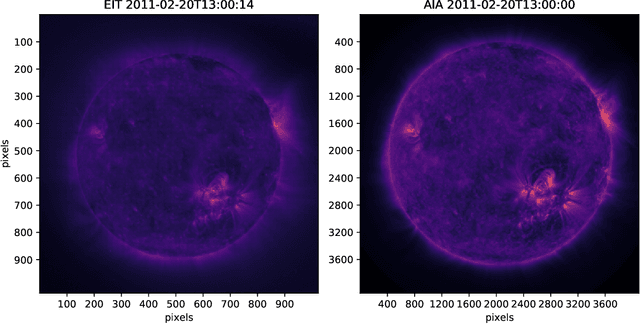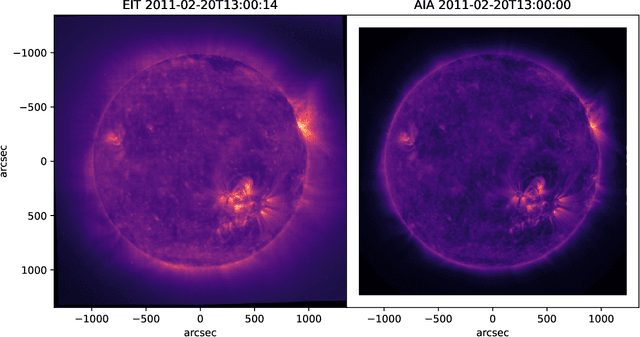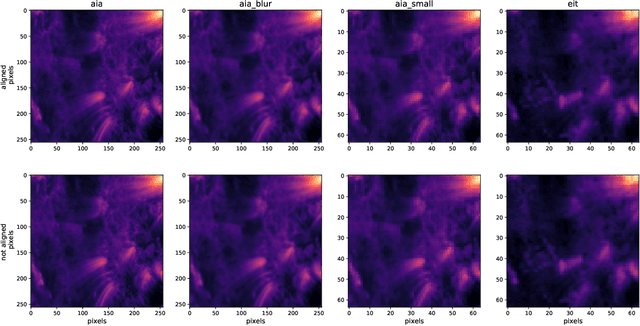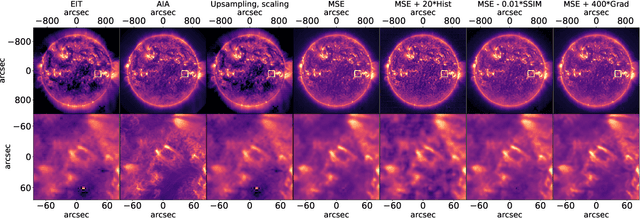Subhamoy Chatterjee
A Machine Learning-Ready Data Processing Tool for Near Real-Time Forecasting
Feb 12, 2025Abstract:Space weather forecasting is critical for mitigating radiation risks in space exploration and protecting Earth-based technologies from geomagnetic disturbances. This paper presents the development of a Machine Learning (ML)- ready data processing tool for Near Real-Time (NRT) space weather forecasting. By merging data from diverse NRT sources such as solar imagery, magnetic field measurements, and energetic particle fluxes, the tool addresses key gaps in current space weather prediction capabilities. The tool processes and structures the data for machine learning models, focusing on time-series forecasting and event detection for extreme solar events. It provides users with a framework to download, process, and label data for ML applications, streamlining the workflow for improved NRT space weather forecasting and scientific research.
Deep Generative model that uses physical quantities to generate and retrieve solar magnetic active regions
Feb 07, 2025



Abstract:Deep generative models have shown immense potential in generating unseen data that has properties of real data. These models learn complex data-generating distributions starting from a smaller set of latent dimensions. However, generative models have encountered great skepticism in scientific domains due to the disconnection between generative latent vectors and scientifically relevant quantities. In this study, we integrate three types of machine learning models to generate solar magnetic patches in a physically interpretable manner and use those as a query to find matching patches in real observations. We use the magnetic field measurements from Space-weather HMI Active Region Patches (SHARPs) to train a Generative Adversarial Network (GAN). We connect the physical properties of GAN-generated images with their latent vectors to train Support Vector Machines (SVMs) that do mapping between physical and latent spaces. These produce directions in the GAN latent space along which known physical parameters of the SHARPs change. We train a self-supervised learner (SSL) to make queries with generated images and find matches from real data. We find that the GAN-SVM combination enables users to produce high-quality patches that change smoothly only with a prescribed physical quantity, making generative models physically interpretable. We also show that GAN outputs can be used to retrieve real data that shares the same physical properties as the generated query. This elevates Generative Artificial Intelligence (AI) from a means-to-produce artificial data to a novel tool for scientific data interrogation, supporting its applicability beyond the domain of heliophysics.
MEMPSEP III. A machine learning-oriented multivariate data set for forecasting the Occurrence and Properties of Solar Energetic Particle Events using a Multivariate Ensemble Approach
Oct 26, 2023Abstract:We introduce a new multivariate data set that utilizes multiple spacecraft collecting in-situ and remote sensing heliospheric measurements shown to be linked to physical processes responsible for generating solar energetic particles (SEPs). Using the Geostationary Operational Environmental Satellites (GOES) flare event list from Solar Cycle (SC) 23 and part of SC 24 (1998-2013), we identify 252 solar events (flares) that produce SEPs and 17,542 events that do not. For each identified event, we acquire the local plasma properties at 1 au, such as energetic proton and electron data, upstream solar wind conditions, and the interplanetary magnetic field vector quantities using various instruments onboard GOES and the Advanced Composition Explorer (ACE) spacecraft. We also collect remote sensing data from instruments onboard the Solar Dynamic Observatory (SDO), Solar and Heliospheric Observatory (SoHO), and the Wind solar radio instrument WAVES. The data set is designed to allow for variations of the inputs and feature sets for machine learning (ML) in heliophysics and has a specific purpose for forecasting the occurrence of SEP events and their subsequent properties. This paper describes a dataset created from multiple publicly available observation sources that is validated, cleaned, and carefully curated for our machine-learning pipeline. The dataset has been used to drive the newly-developed Multivariate Ensemble of Models for Probabilistic Forecast of Solar Energetic Particles (MEMPSEP; see MEMPSEP I (Chatterjee et al., 2023) and MEMPSEP II (Dayeh et al., 2023) for associated papers).
Efficient labeling of solar flux evolution videos by a deep learning model
Aug 29, 2023Abstract:Machine learning (ML) is becoming a critical tool for interrogation of large complex data. Labeling, defined as the process of adding meaningful annotations, is a crucial step of supervised ML. However, labeling datasets is time consuming. Here we show that convolutional neural networks (CNNs), trained on crudely labeled astronomical videos, can be leveraged to improve the quality of data labeling and reduce the need for human intervention. We use videos of the solar magnetic field, crudely labeled into two classes: emergence or non-emergence of bipolar magnetic regions (BMRs), based on their first detection on the solar disk. We train CNNs using crude labels, manually verify, correct labeling vs. CNN disagreements, and repeat this process until convergence. Traditionally, flux emergence labelling is done manually. We find that a high-quality labeled dataset, derived through this iterative process, reduces the necessary manual verification by 50%. Furthermore, by gradually masking the videos and looking for maximum change in CNN inference, we locate BMR emergence time without retraining the CNN. This demonstrates the versatility of CNNs for simplifying the challenging task of labeling complex dynamic events.
* 16 pages, 7 figures, published in Nature Astronomy, June 27, 2022
Probabilistic solar flare forecasting using historical magnetogram data
Aug 29, 2023Abstract:Solar flare forecasting research using machine learning (ML) has focused on high resolution magnetogram data from the SDO/HMI era covering Solar Cycle 24 and the start of Solar Cycle 25, with some efforts looking back to SOHO/MDI for data from Solar Cycle 23. In this paper, we consider over 4 solar cycles of daily historical magnetogram data from multiple instruments. This is the first attempt to take advantage of this historical data for ML-based flare forecasting. We apply a convolutional neural network (CNN) to extract features from full-disk magnetograms together with a logistic regression model to incorporate scalar features based on magnetograms and flaring history. We use an ensemble approach to generate calibrated probabilistic forecasts of M-class or larger flares in the next 24 hours. Overall, we find that including historical data improves forecasting skill and reliability. We show that single frame magnetograms do not contain significantly more relevant information than can be summarized in a small number of scalar features, and that flaring history has greater predictive power than our CNN-extracted features. This indicates the importance of including temporal information in flare forecasting models.
Homogenising SoHO/EIT and SDO/AIA 171Å$~$ Images: A Deep Learning Approach
Aug 20, 2023



Abstract:Extreme Ultraviolet images of the Sun are becoming an integral part of space weather prediction tasks. However, having different surveys requires the development of instrument-specific prediction algorithms. As an alternative, it is possible to combine multiple surveys to create a homogeneous dataset. In this study, we utilize the temporal overlap of SoHO/EIT and SDO/AIA 171~\AA ~surveys to train an ensemble of deep learning models for creating a single homogeneous survey of EUV images for 2 solar cycles. Prior applications of deep learning have focused on validating the homogeneity of the output while overlooking the systematic estimation of uncertainty. We use an approach called `Approximate Bayesian Ensembling' to generate an ensemble of models whose uncertainty mimics that of a fully Bayesian neural network at a fraction of the cost. We find that ensemble uncertainty goes down as the training set size increases. Additionally, we show that the model ensemble adds immense value to the prediction by showing higher uncertainty in test data that are not well represented in the training data.
 Add to Chrome
Add to Chrome Add to Firefox
Add to Firefox Add to Edge
Add to Edge